Henslin James M. Sociology: A Down to Earth Approach
Подождите немного. Документ загружается.


prices for large houses that, although deteriorated, can be restored. With gentrification
comes an improvement in the appearance of the neighborhood—freshly painted build-
ings, well-groomed lawns, and the absence of boarded-up windows.
Gentrification received a black eye because it was thought that the more well-to-do new-
comers displaced the poorer residents, that they took over their turf, so to speak. While there
certainly are tensions with the newcomers (Anderson 1990, 2006), a recent study indicates
that gentrification also draws middle-class minorities to the neighborhood and improves their
incomes (McKinnish et al. 2008). We will have to see if further research confirms this finding.
The usual pattern is for the gentrifiers to be whites and the earlier residents to be minori-
ties, but in the Harlem neighborhood of New York City, both groups are African Americans.
As is discussed in the Down-to-Earth Sociology box on the next page, as middle-class and pro-
fessional African Americans reclaim this area, an infrastructure—which includes everything
from Starbucks coffee shops to dentists—is following. So are soaring real estate prices.
From City to Suburb. The term suburbanization refers to people moving from cities to
suburbs, the communities located just outside a city. Suburbanization is not new. The Mayan
city of Caracol (in what is now Belize) had suburbs, perhaps even with specialized subcen-
ters, the equivalent of today’s strip malls (Wilford 2000). The extent to which people have
left U.S. cities in search of their dreams is remarkable. In 1920, about 15 percent of Ameri-
cans lived in the suburbs, and today over half of all Americans live in them (Palen 2008).
After the racial integration of U.S. schools in the 1950s and 1960s, whites fled the city.
Starting around 1970, minorities also began to move to the suburbs, where in some they
have become the majority. “White flight” appears to have ended (Dougherty 2008a).
Although only a trickle at this point, the return of whites to the city is significant enough
that in Washington, D.C., and San Francisco, California, some black churches and busi-
nesses are making the switch to a white clientele. In a reversal of patterns, some black
churches are now fleeing the city, following their parishioners to the suburbs.
Smaller Centers. The most recent urban trend is the development of micropolitan areas.
A micropolis is a city of 10,000 to 50,000 residents that is not a suburb (McCarthy 2004),
such as Gallup, New Mexico, or Carbondale, Illinois. Most micropolises are located “next
to nowhere.” They are fairly self-contained in terms of providing work, housing, and en-
tertainment, and few of their residents commute to urban centers for work. Micropolises
are growing, as residents of both rural and urban areas find their cultural attractions and
conveniences appealing, especially in the absence of the city’s crime and pollution.
The Rural Rebound
The desire to retreat to a safe haven has led to a migration to rural areas that is without
precedent in the history of the United States. Some small farming towns are making a
comeback, their boarded-up stores and schools once again open for business and learning.
The Development of Cities 611
TABLE 20.4 The Shrinking and the Fastest-Growing Cities
Note: Population change from 2000 to 2009, the latest years available.
The Shrinking Cities
1. –9.6% New Orleans, LA 1. +47.4% Provo, UT
2. –6.6% Youngstown, OH 2. +41.2% Raleigh, NC
3. –4.0% Buffalo–Niagara Falls, NY 3. +40.9% Greeley, CO
4. –3.1% Pittsburgh, PA 4. +38.3% Las Vegas, NV
5. –2.8% Flint, MI 5. +36.4% Austin, TX
6. –2.6% Cleveland, OH 6. +34.2% Phoenix, AZ
7. –2.2% Utica-Rome, NY 7. +34.2% Myrtle Beach, SC
8. –2.0% Scranton, PA 8. +33.9% Fayetteville, AR
9. –1.8% Charleston,WV 9. +33.1% Cape Coral-Ft. Myers, FL
10. –1.7% Beaumont,TX 10. +31.2% Charlotte, NC
The Fastest-Growing Cities
suburbanization the migra-
tion of people from the city to
the suburbs
suburb a community adjacent
to a city
Source: By the author. Based on Statistical Abstract of the United States 2011:Table 20.
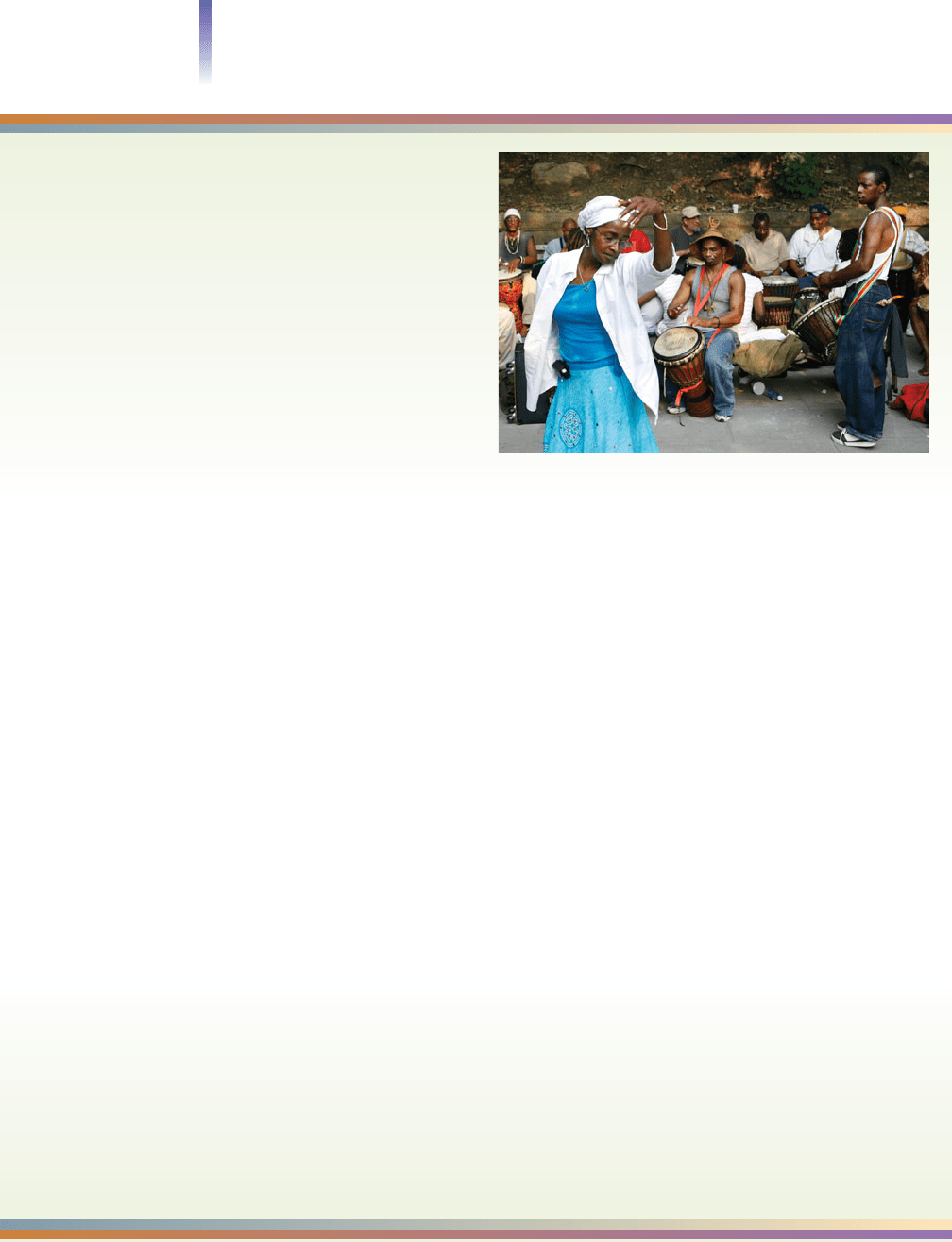
Reclaiming Harlem: A Twist in the
Invasion–Succession Cycle
T
he story is well known.The inner city is filled with
crack, crime, and corruption. It stinks from foul, fes-
tering filth strewn on the streets and piled up
around burned-out buildings. Only those who have no
choice live in these desolate, despairing areas where dan-
ger lurks around every corner.
What is not so well known is that affluent African
Americans are reclaiming some of these areas.
Howard Sanders was living the American Dream.After
earning a degree from Harvard Business School, he took a
position with a Manhattan investment firm. He lived in an
exclusive apartment on Central Park West, but he missed
Harlem, where he had grown up. He moved back, along
with his wife and daughter.
African American lawyers, doctors, professors, and
bankers are doing the same.
What’s the attraction? The first is nostalgia, a cultural iden-
tification with the Harlem of legend and folklore. It was here
that black writers and artists lived in the 1920s, here that the
blues and jazz attracted young and accomplished musicians.
The second reason is that Harlem offers housing val-
ues, such as five-bedroom homes with 6,000 square feet,
some with Honduran mahogany. Some brownstones are
only shells and have to be rebuilt from the inside out.
Others are in perfect condition.
What is happening is the rebuilding of a community.
Some people who “made” it want to be role models.They
want children in the community to see them going to and
returning from work.
When the middle class moved out of Harlem, so did its
amenities. Now that young professionals are moving back
in, the amenities are returning.There were no coffee
shops, restaurants, jazz clubs, florists, copy centers, dentist
and optometrist offices, or art galleries—the types of
things urbanites take for granted. Now there are.
The police are also helping to change the character of
Harlem. No longer do they just rush in, sirens wailing, to
confront emergencies and shootouts. Instead, the police
have become a normal part of this urban scene. Not only
have they shut down the open-air drug markets, but they
are even enforcing laws against public urination and
vagrancy.The greater safety of the area is attracting
even more of the middle class.
Two of the strongest signs of the change are that for-
mer president Clinton chose to locate his office here,
and Magic Johnson opened a Starbucks and a multiplex.
There is another side of the story, of course, the ten-
sion between the old timers, the people who were al-
ready living in Harlem, and the newcomers, the investment
bankers and professionals who are moving back and trying
to rediscover their roots. Sometimes cultural differences
become a problem.The old timers like loud music, for
example, while the newcomers prefer a more sedate
lifestyle. On a more serious level are the tenants’ associa-
tions that protest the increase in rents and the homeown-
ers’ associations that fight to keep renters out of their
rehabilitated areas. All are African Americans.The issue is
not race, but social class antagonisms.
The “invasion-succession cycle,” as sociologists call it,
is continuing, but this time with a twist—a flight back in.
For Your Consideration
Would you be willing to move into an area of high
crime in order to get a good housing bargain? How do
you think the economic crisis—with the loss of jobs
and falling real estate prices—will affect Harlem?
Sources: Based on Cose 1999; McCormick 1999b; Leland 2003; Hamp-
son 2005; Hyra 2006; Beveridge 2008; Williams 2008; Haughney 2009.
Social class preferences in music styles and volume are a source of
tension between the old and new residents of Harlem. New residents
have complained about these musicians at Marcus Garvey Park.
Down-to-Earth Sociology
In some cases, towns have even become too expensive for families that had lived there for
decades (Dougherty 2008b).
The “push” factors for this fundamental shift are fears of urban crime and violence.
The “pull” factors are safety, lower cost of living, and more living space. Interstate highways
have made airports—and the city itself—accessible from longer distances. With satellite
612 Chapter 20 POPULATION AND URBANIZATION

Models of Urban Growth 613
communications, cell phones, fax machines, and the Internet, people can be “plugged
in”—connected with others around the world—even though they live in what just a short
time ago were remote areas.
Listen to the wife of one of my former students as she explains why she and her hus-
band moved to a rural area, three hours from the international airport that they fly out
of each week:
I work for a Canadian company. Paul works for a French company, with headquarters in
Paris. He flies around the country doing computer consulting. I give motivational seminars
to businesses. When we can, we drive to the airport together, but we often leave on different
days. I try to go with my husband to Paris once a year.
We almost always are home together on the weekends. We often arrange three- and four-
day weekends, because I can plan seminars at home, and Paul does some of his consulting
from here.
Sometimes shopping is inconvenient, but we don’t have to lock our car doors when we
drive, and the new Wal-Mart superstore has most of what we need. E-commerce is a big part
of it. I just type in www—whatever, and they ship it right to my door. I get make-up and
books online. I even bought a part for my stove.
Why do we live here? Look at the lake. It’s beautiful. We enjoy boating and swimming.
We love to walk in this parklike setting. We see deer and wild turkeys. We love the sunsets
over the lake. (author’s files)
She added, “I think we’re ahead of the learning curve,” referring to the idea that their
lifestyle is a wave of the future.
Models of Urban Growth
In the 1920s, Chicago was a vivid mosaic of immigrants, gangsters, prostitutes, the home-
less, the rich, and the poor—much as it is today. Sociologists at the University of Chicago
studied these contrasting ways of life. One of these sociologists, Robert Park, coined the
term human ecology to describe how people adapt to their environment (Park and
Burgess 1921; Park 1936). (This concept is also known as urban ecology.) The process of
urban growth is of special interest to sociologists. Let’s look at four main models they
developed.
The Concentric Zone Model
To explain how cities expand, sociologist Ernest Burgess (1925) proposed a concentric-
zone model. As shown in part A of Figure 20.13 on the next page, Burgess noted that a
city expands outward from its center. Zone 1 is the central business district. Zone 2,
which encircles the downtown area, is in transition. It contains rooming houses and de-
teriorating housing, which Burgess said breed poverty, disease, and vice. Zone 3 is the
area to which thrifty workers have moved in order to escape the zone in transition and
yet maintain easy access to their work. Zone 4 contains more expensive apartments, res-
idential hotels, single-family homes, and exclusive areas where the wealthy live. Com-
muters live in Zone 5, which consists of suburbs or satellite cities that have grown up
around transportation routes.
Burgess intended this model to represent “the tendencies of any town or city to ex-
pand radially from its central business district.” He noted, however, that no “city fits per-
fectly this ideal scheme.” Some cities have physical obstacles such as a lake, river, or railroad
that cause their expansion to depart from the model. Burgess also noted that businesses
had begun to deviate from the model by locating in outlying zones (see Zone 10). That
was in 1925. Burgess didn’t know it, but he was seeing the beginning of a major shift that
led businesses away from downtown areas to suburban shopping malls. Today, these malls
account for most of the country’s retail sales.
human ecology Robert
Park’s term for the relationship
between people and their en-
vironment (such as land and
structures); also known as
urban ecology
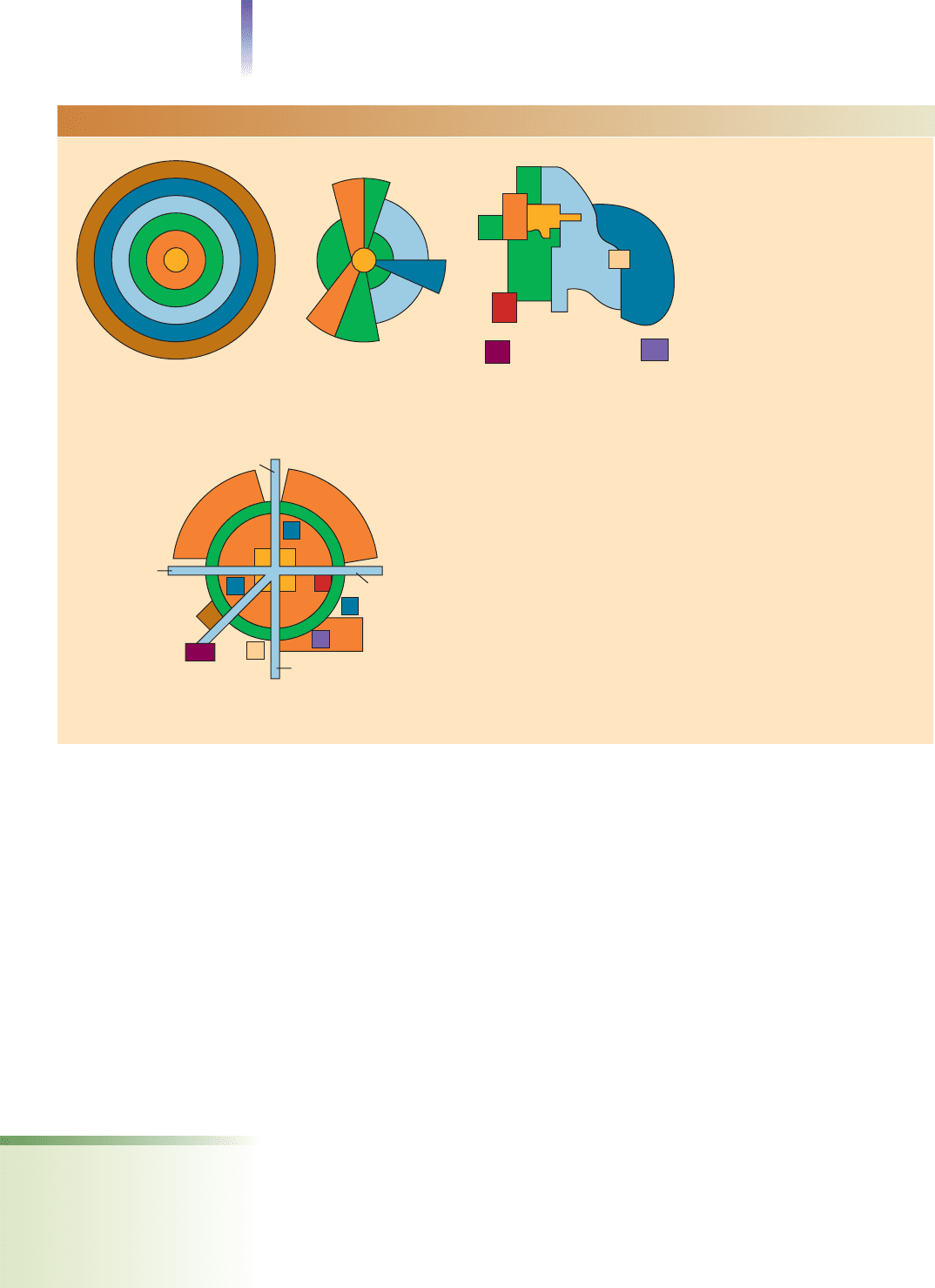
The Sector Model
Sociologist Homer Hoyt (1939, 1971) noted that a city’s concentric zones do not form a
complete circle, and he modified Burgess’ model of urban growth. As shown in part B of
Figure 20.13, a concentric zone can contain several sectors—one of working-class housing, an-
other of expensive homes, a third of businesses, and so on—all competing for the same land.
An example of this dynamic competition is what sociologists call an invasion–succession
cycle. Poor immigrants and rural migrants settle in low-rent areas. As their numbers swell,
they spill over into adjacent areas. Upset by their presence, the middle class moves out,
which expands the sector of low-cost housing. The invasion-succession cycle is never com-
plete, for later another group will replace this earlier one. The cycle, in fact, can go full cir-
cle. As discussed in the Down-to Earth Sociology box on page 612, in Harlem there has been
a switch in the sequence: The “invaders” are the middle class
The Multiple-Nuclei Model
Geographers Chauncey Harris and Edward Ullman noted that some cities have several cen-
ters or nuclei (Harris and Ullman 1945; Ullman and Harris 1970). As shown in part C of
Figure 20.13, each nucleus contains some specialized activity. A familiar example is the clus-
tering of fast-food restaurants in one area and automobile dealers in another. Sometimes
similar activities are grouped together because they profit from cohesion; retail districts, for
example, draw more customers if there are more stores. Other clustering occurs because
some types of land use, such as factories and expensive homes, are incompatible with one
another. One result is that services are not spread evenly throughout the city.
614 Chapter 20 POPULATION AND URBANIZATION
1.
2.
3.
4.
5.
6.
7.
8.
9.
10.
Central business district
Wholesale and light
manufacturing
Low-class residential
Medium-class residential
High-class residential
Heavy manufacturing
Outlying business district
Residential suburb
Industrial suburb
Commuters’ zone
Districts (for Parts A, B, C)
2
1
3
3
3
4
7
5
6
9
8
Multiple nuclei
(C)
5
1
2
4
3
4
3
3
3
3
2
Sectors
(B)
1
2
5
4
10
3
Concentric zones
(A)
1.
2.
3.
4.
5.
6.
7.
8.
9.
10.
Central city
Suburban residential areas
Circumferential highway
Radial highway
Shopping mall
Industrial district
Office park
Service center
Airport complex
Combined employment
and shopping center
Districts (for Part D)
Peripheral model
(D)
5
5
5
6
7
9
8
10
2
2
2
2
22
1
1
1
3
3
3
2
4
4
4
4
FIGURE 20.13 How Cities Develop: Models of Urban Growth
Source: Cousins and Nagpaul 1970; Harris 1997.
invasion–succession cycle
the process of one group of
people displacing a group
whose racial–ethnic or social
class characteristics differ from
their own

The Peripheral Model
Chauncey Harris (1997) also developed the peripheral model shown in part D of Figure
20.13. This model portrays the impact of radial highways on the movement of people and
services away from the central city to the city’s periphery, or outskirts. It also shows the
development of industrial and office parks.
Critique of the Models
These models tell only part of the story. They are time bound, for medieval cities didn’t fol-
low these patterns (see the photo on page 605). In addition, they do not account for urban
planning policies. England, for example, has planning laws that preserve green belts (trees
and farmlands) around the city. This prevents urban sprawl: Wal-Mart cannot buy land out-
side the city and put up a store; instead, it must locate in the downtown area with the other
stores. Norwich has 250,000 people—yet the city ends abruptly in a green belt where pheas-
ants skitter across plowed fields while sheep graze in verdant meadows (Milbank 1995).
If you were to depend on these models, you would be surprised when you visit the cities
of the Least Industrialized Nations. There, the wealthy often claim the inner city, where fine
restaurants and other services are readily accessible. Tucked behind walls and protected
from public scrutiny, they enjoy luxurious homes and gardens. The poor, in contrast, es-
pecially rural migrants, settle in areas outside the city—or, as in the case of El Tiro, featured
in the photo essay on pages 606–607, on top of piles of garbage in what used to be the out-
skirts of a city. This topic is discussed in the Cultural Diversity box on the next page.
City Life
Life in cities is filled with contrasts. Let’s look at two of those contrasts, alienation and
community.
Alienation in the City
In a classic essay, sociologist Louis Wirth (1938) noted that urban dwellers live anonymous
lives marked by segmented and superficial encounters. This type of relationship, he said,
undermines kinship and neighborhood, the traditional bases of social control and feelings
of solidarity. Urbanites then grow aloof and indifferent to other people’s problems. In
short, the price of the personal freedom that the city offers is alienation. Seldom, however,
does alienation get to this point:
In crowded traffic on a bridge going into Detroit, Deletha Word bumped the car ahead of her.
The damage was minor, but the driver, Martell Welch, jumped out. Cursing, he pulled
Deletha from her car, pushed her onto the hood, and began beating her. Martell’s friends got
out to watch. One of them held Deletha down while Martell took a car jack and smashed
Deletha’s car. Scared for her life, Deletha broke away, fleeing to the bridge’s railing. Martell
and his friends taunted her, shouting, “Jump, bitch, jump!” Deletha plunged to her death.
(Newsweek, September 4, 1995). Welch was convicted of second degree murder and sen-
tenced to 16 to 40 years in prison.
This certainly is not an ordinary situation, but anyone who lives in a large city knows
that it is prudent to be alert to danger. Even a minor traffic accident can explode into road
rage. And you never know who that stranger in the mall—or even next door–really is. Few
city dwellers cower in fear, of course, but a common response to the potential of urban dan-
ger is to be wary and to “mind your own business.” At a minimum, to deal with the crowds
of strangers with whom they temporarily share the same urban space, urbanites avoid need-
less interaction with others and are absorbed in their own affairs. The most common rea-
son for impersonality and self-interest is not fear of danger, however, but the impossibility
of dealing with crowds as individuals and the need to find focus within the many stimuli
that come buzzing in from the bustle of the city (Berman et al. 2008).
City Life 615
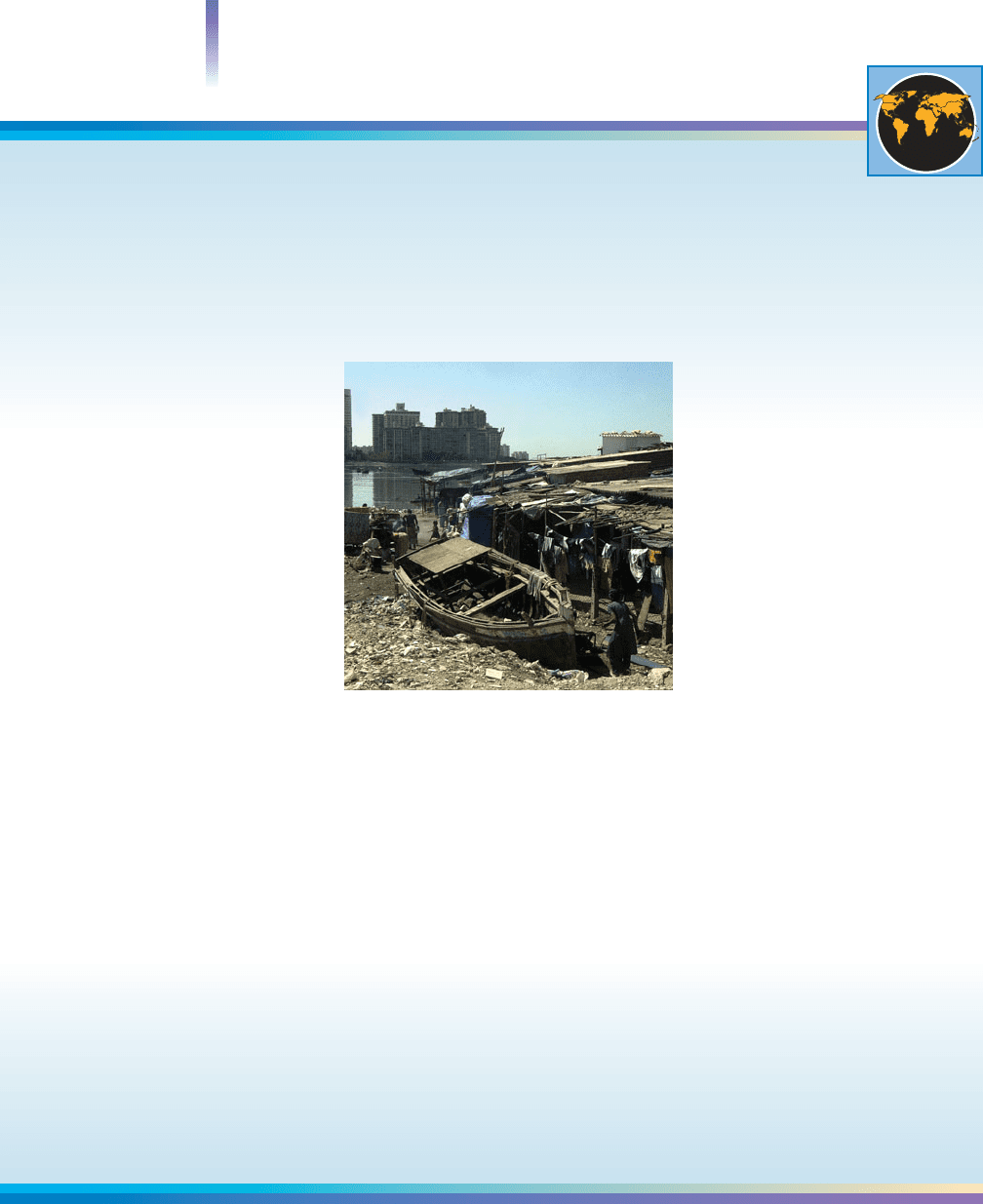
Community in the City
I don’t want to give the impression that the city is inevitably alienating. Far from it. Many peo-
ple find that living in the city is a pleasant experience. There are good reasons that millions
around the world are rushing to live there. And there is another aspect of the attack on Deletha
Word. After Deletha went over the railing, two men jumped in after her, risking injury and
their own lives in a futile attempt to save her. Some urbanites, then, are far from alienated.
616 Chapter 20 POPULATION AND URBANIZATION
Cultural Diversity around the World
Why City Slums Are Better
Than the Country: Urbanization
in the Least Industrialized
Nations
At the bottom of a ravine near Mex-
ico City is a bunch of shacks. Some of
the parents have 14 children.“We
used to live up there,” Señora Gonza-
lez gestured toward the mountain,“in
those caves. Our only hope was one
day to have a place to live.And now
we do.” She smiled with pride at the
jerry-built shacks...each one had a col-
lection of flowers planted in tin cans.
“One day, we hope to extend the
water pipes and drainage—perhaps
even pave ....”
And what was the name of her
community? Señora Gonzalez beamed.
“Esperanza!” (McDowell 1984:172)
Esperanza is the Spanish word
for hope.
What started as a trickle has be-
come a torrent. In 1930, only one Latin
American city had over a million people—now fifty do!
The world’s cities are growing by one million people each
week (Brockerhoff 2000).The rural poor are flocking to
the cities at such a rate that, as we saw in Figure 20.11 on
page 609, these nations now contain most of the world’s
largest cities.
When migrants move to U.S. cities, they usually settle
in rundown housing near the city’s center.The wealthy live
in suburbs and luxurious city enclaves. Migrants to cities of
the Least Industrialized Nations, in contrast, establish ille-
gal squatter settlements outside the city.There they build
shacks from scrap boards, cardboard, and bits of corru-
gated metal. Even flattened tin cans are scavenged for
building material.The squatters enjoy no city facilities—
roads, public transportation, water, sewers, or garbage
pickup.After thousands of squatters have settled an area,
the city reluctantly acknowledges their right to live there
and adds bus service and minimal water lines. Hundreds of
people use a single spigot.About 5 million of Mexico City’s
residents live in such squalid condi-
tions, with hundreds of thousands
more pouring in each year.
Why this rush to live in the
city under such miserable condi-
tions? On the one hand are the
“push” factors that come from
the breakdown of traditional
rural life. More children are sur-
viving because of a safer water
supply and modern medicine.As
rural populations multiply, the
parents no longer have enough
land to divide among their chil-
dren.With neither land nor jobs,
there is hunger and despair. On
the other hand are the “pull”
factors that draw people to the
cities—jobs, schools, housing, and
even a more stimulating life.
How will the Least Industrial-
ized Nations adjust to this vast migration? Authorities in
Brazil, Guatemala,Venezuela, and other countries have
sent in the police and even the army to evict the settlers.
Force doesn’t work. After a violent dispersal, the settlers
return—and others stream in.The roads, water and sewer
lines, electricity, schools, and public facilities must be built.
But these poor countries don’t have the resources to
build them. As wrenching as the adjustment will be, to
survive these countries must—and somehow will—make
the transition.They have no choice.
For Your Consideration
What solutions do you see to the vast migration to the
cities of the Least Industrialized Nations?
It is difficult for Americans to grasp the depth of
poverty that is the everyday life of hundreds of mil-
lions of people across the world. This photo was
taken in Bombay, India. In the background, is one
of India’s main financial centers.
The World
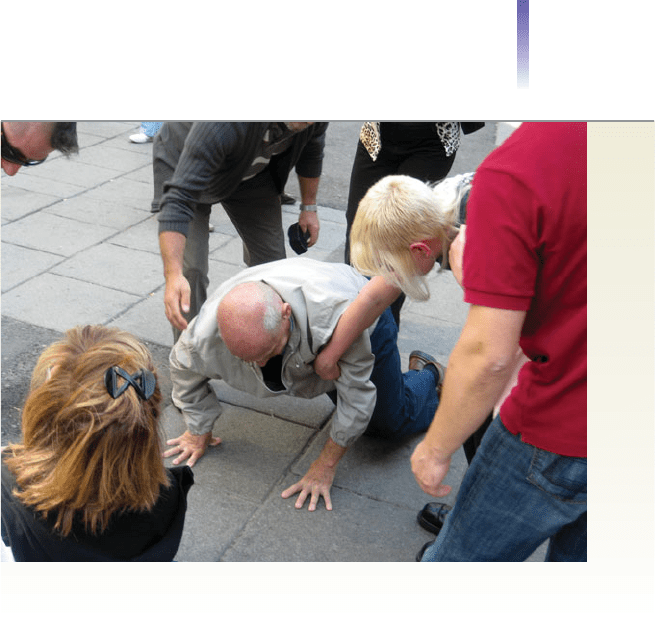
To the contrary, many people find commu-
nity in the city. Sociologist Herbert Gans, a
symbolic interactionist who did participant ob-
servation in the West End of Boston, was so im-
pressed with the area’s sense of community that
he titled his book The Urban Villagers (1962).
In this book, which has become a classic in so-
ciology, Gans said:
After a few weeks of living in the West End, my
observations—and my perceptions of the area—
changed drastically. The search for an apartment
quickly indicated that the individual units were
usually in much better condition than the out-
side or the hallways of the buildings. Subse-
quently, in wandering through the West End,
and in using it as a resident, I developed a kind
of selective perception, in which my eye focused
only on those parts of the area that were actu-
ally being used by people. Vacant buildings and
boarded-up stores were no longer so visible, and
the totally deserted alleys or streets were outside
the set of paths normally traversed, either by
myself or by the West Enders. The dirt and spilled-over garbage remained, but, since they
were concentrated in street gutters and empty lots, they were not really harmful to anyone
and thus were not as noticeable as during my initial observations.
Since much of the area’s life took place on the street, faces became familiar very quickly.
I met my neighbors on the stairs and in front of my building. And, once a shopping pat-
tern developed, I saw the same storekeepers frequently, as well as the area’s “characters”
who wandered through the streets everyday on a fairly regular route and schedule. In
short, the exotic quality of the stores and the residents also wore off as I became used to
seeing them.
In short, Gans found a community, people who identified with the area and with one
another. Its residents enjoyed networks of friends and acquaintances. Despite the area’s
substandard buildings, most West Enders had chosen to live here. To them, this was a low-
rent district, not a slum.
Most West Enders had low-paying, insecure jobs. Other residents were elderly, liv-
ing on small pensions. Unlike the middle class, these people didn’t care about their
“address.” The area’s inconveniences were something they put up with in exchange for
cheap housing. In general, they were content with their neighborhood.
Who Lives in the City?
Whether people find alienation or community in the city depends on whom you are talk-
ing about. As with almost everything in life, social class is especially significant. The greater
security enjoyed by the city’s wealthier residents reduces alienation and increases satisfac-
tion with city life (Santos 2009). There also are different types of urban dwellers, each with
distinctive experiences. As we review the five types that Gans (1962, 1968, 1991) identi-
fied, try to see where you fit.
The Cosmopolites. These are the intellectuals, professionals, artists, and entertainers
who have been attracted to the city. They value its conveniences and cultural benefits.
The Singles. Usually in their early 20s to early 30s, the singles have settled in the city
temporarily. For them, urban life is a stage in their life course. Businesses and services, such
City Life 617
The city doesn’t have to be an anomic, unfriendly place.This elderly man who fell
onto the sidewalk in Vienna is helped by concerned strangers. (After I snapped
this photo, a police officer approached me and asked why I took it.)
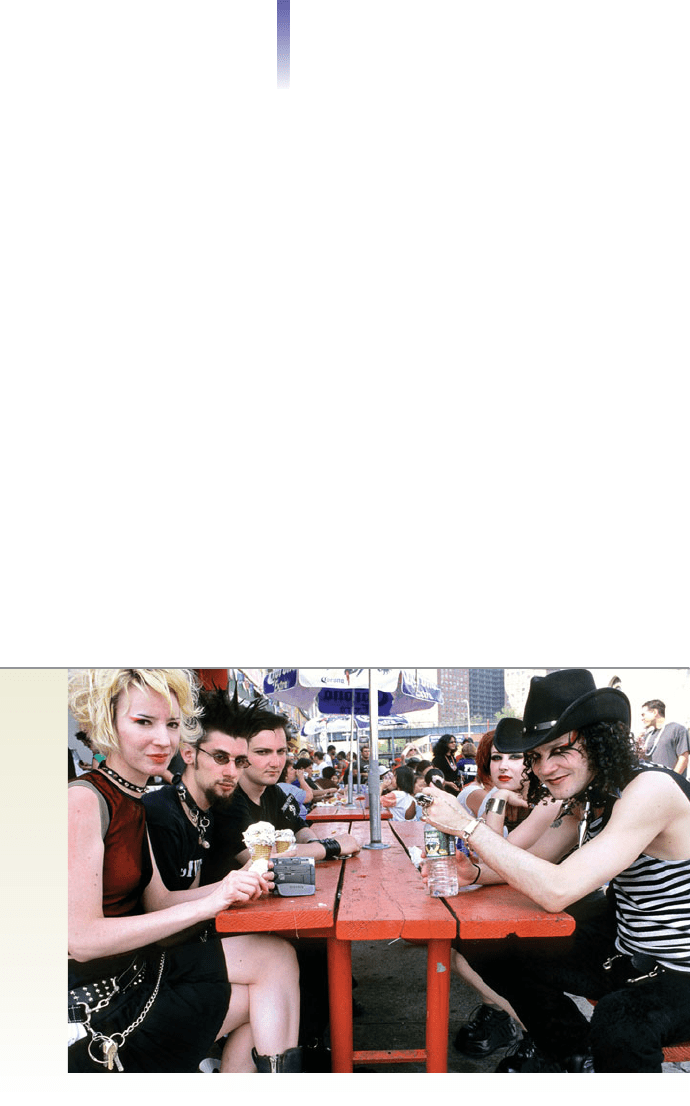
as singles bars and apartment complexes, cater to their needs and desires. After they marry,
many move to the suburbs.
The Ethnic Villagers. Feeling a sense of identity, working-class members of the same
ethnic group band together. They form tightly knit neighborhoods that resemble villages
and small towns. Family- and peer-oriented, they try to isolate themselves from the dan-
gers and problems of urban life.
The Deprived. Destitute, emotionally disturbed, and having little income, education,
or work skills, the deprived live in neighborhoods that are more like urban jungles than
urban villages. Some of them stalk those jungles in search of prey. Neither predator nor
prey has much hope for anything better in life—for themselves or for their children.
The Trapped. These people don’t live in the area by choice, either. Some were trapped
when an ethnic group “invaded” their neighborhood and they could not afford to move.
Others found themselves trapped in a downward spiral. They started life in a higher so-
cial class, but because of personal problems—mental or physical illness or addiction to al-
cohol or other drugs—they drifted downward. There also are the elderly who are trapped
by poverty and not wanted elsewhere. Like the deprived, the trapped suffer from high
rates of assault, mugging, and rape.
Critique. You probably noticed this inadequacy in Gans’ categories, that you can be both
a cosmopolite and a single. You might have noticed also that you can be these two things
and an ethnic villager as well. Gans also
seems to have missed an important type of
city dweller—the people who live in the city
who don’t stand out in any way. They work
and marry there and quietly raise their fam-
ilies. They aren’t cosmopolites, singles, or
ethnic villagers. Neither are they deprived
nor trapped. Perhaps we can call these the
“Just Plain Folks.”
In Sum: Within the city’s rich mosaic of so-
cial diversity, not all urban dwellers experience
the city in the same way. Each group has its
own lifestyle, and each has distinct experi-
ences. Some people welcome the city’s cultural
diversity and mix with several groups. Others
find community by retreating into the secu-
rity of ethnic enclaves. Still others feel trapped
and deprived. To them, the city is an urban
jungle. It poses threats to their health and
safety, and their lives are filled with despair.
The Norm of Noninvolvement and
the Diffusion of Responsibility
Urban dwellers try to avoid intrusions from strangers. As they go about their everyday lives
in the city, they follow a norm of noninvolvement.
To do this, we sometimes use props such as newspapers to shield ourselves from others
and to indicate our inaccessibility for interaction. In effect, we learn to “tune others out.”
In this regard, we might see the [iPod] as the quintessential urban prop in that it allows us
to be tuned in and tuned out at the same time. It is a device that allows us to enter our own
private world and thereby effectively to close off encounters with others. The use of such
devices protects our “personal space,” along with our body demeanor and facial expres-
sion (the passive “mask” or even scowl that persons adopt on subways). (Karp et al. 1991)
618 Chapter 20 POPULATION AND URBANIZATION
Where do you think these people fit in Gans’ classification of urban dwellers?

City Life 619
Urban Fear and the
Gated Fortress
G
ated neighborhoods—where gates open and close
to allow or prevent access to a neighborhood—
are not new.They always have been available to
the rich.What is new is the rush of the upper middle class
to towns where they pay high taxes to keep all of the
town’s facilities private. Even the city’s streets are private.
Towns cannot discriminate on the basis of religion or
race–ethnicity, but they can—and do— discriminate on
the basis of social class. Klahanie,Washington, is an excel-
lent example. Begun in 1985, it was supposed to take
twenty years to develop.With its winding streets, pavil-
ions, gardens, swimming pools, parks, private libraries, in-
fant-toddler playcourt, and 25 miles of hiking-bicycling-
running trails on 900 acres of open space, Easter egg
hunts, and Fourth of July parties, demand for the
$300,000 to $500,000 homes nestled by a lake in this pri-
vate community exceeded supply (Egan 1995; Klahanie
Association Web site 2009).
As the upper middle class flees urban areas and tries
to build a bucolic dream, we will see many more private
towns. A strong sign of the future is Celebration, a town
of 20,000 people planned and built by the Walt Disney
Company just five minutes from Disney World. Celebra-
tion boasts the usual school, hospital, and restaurants. In
addition, Celebration offers a Robert Trent Jones golf
course, walking and bicycling paths, a hotel with a light-
house tower and bird sanctuary, a health and fitness
center with a rock-climbing wall, and its own cable TV
channel.With fiber-optic technology, the residents of pri-
vate communities can remain locked within their sanctu-
aries and still be connected to the outside world.
For Your Consideration
Community involves a sense of togetherness, an identifying
with one another. Can you explain how this concept also
contains the idea of separateness from others (not just in
the example of gated communities)? What will our future
be if we become a nation of gated communities, where mid-
dle-class homeowners withdraw into private domains, sepa-
rating themselves from the rest of the nation?
To protect themselves, primarily from the poor, the
upper middle class increasingly seeks sanctuary
behind gated communities. This photo was taken
in Florida.
Down-to-Earth Sociology
Social psychologists John Darley and Bibb Latané (1968) ran the series of experiments
featured in Chapter 6, pages 162–163. In their experiments, they uncovered the diffusion
of responsibility—the more bystanders there are, the less likely people are to help. As a
group grows, people’s sense of responsibility becomes diffused, with each person assum-
ing that another will do the responsible thing. “With these other people here, it is not my
responsibility,” they reason.
The diffusion of responsibility helps to explain why people can ignore the plight of oth-
ers. Those who did nothing to intervene in the attack on Deletha Word were not uncar-
ing people. Each felt that others might do something. Then, too, there was the norm of
noninvolvement—helpful for getting people through everyday city life but, unfortunately,
dysfunctional in some crucial situations.
To this dispassionate analysis of diffusion of responsibility and norm of noninvolve-
ment, we can add this: These people were scared. They didn’t want to get hurt. The fears
nurtured by events like the sudden attack on a motorist, as well as the city’s many rapes
and muggings, make many people want to retreat to a safe haven. This topic is discussed
in the Down-to-Earth Sociology box below.

Urban Problems and Social Policy
To close this chapter, let’s look at the primary reasons that U.S. cities have
declined, and then consider the potential of urban revitalization.
Suburbanization
The U.S. city has been the loser in the transition to the suburbs. As people
moved out of the city, businesses and jobs followed. White-collar corpora-
tions, such as insurance companies, were the first to move their offices to
the suburbs. They were soon followed by manufacturers. This process has
continued so relentlessly that today twice as many manufacturing jobs are
located in the suburbs as in the city (Palen 2008). As the city’s tax base
shrank, it left a budget squeeze that affected not only parks, zoos, libraries,
and museums, but also the city’s basic services—its schools, streets, sewer
and water systems, and police and fire departments.
This shift in population and resources left behind people who had no
choice but to stay in the city. As we reviewed in Chapter 12, sociologist
William Julius Wilson says that this exodus transformed the inner city into
a ghetto. Left behind were families and individuals who, lacking training
and skills, were trapped by poverty, unemployment, and welfare depend-
ency. Also left behind were those who prey on others through street crime.
The term ghetto, says Wilson, “suggests that a fundamental social transfor-
mation has taken place...that groups represented by this term are collec-
tively different from and much more socially isolated from those that lived
in these communities in earlier years” (quoted in Karp et al. 1991).
City Versus Suburb. Having made the move out of the city—or having
been born in a suburb and preferring to stay there—suburbanites want the
city to keep its problems to itself. They reject proposals to share suburbia’s revenues with
the city and oppose measures that would allow urban and suburban governments joint
control over what has become a contiguous mass of people and businesses. Suburban lead-
ers generally believe that it is in their best interests to remain politically, economically,
and socially separate from their nearby city. They do not mind going to the city to work,
or venturing there on weekends for the diversions it offers, but they do not want to help
pay the city’s expenses.
It is likely that the mounting bill ultimately will come due, however, and that subur-
banites will have to pay for their uncaring attitude toward the urban disadvantaged. Karp
et al. (1991) put it this way:
It may be that suburbs can insulate themselves from the problems of central cities, at least
for the time being. In the long run, though, there will be a steep price to pay for the failure
of those better off to care compassionately for those at the bottom of society.
Our occasional urban riots may be part of that bill—perhaps just the down payment.
Suburban Flight. In some places, the bill is coming due quickly. As they age, some sub-
urbs are becoming mirror images of the city that their residents so despise. Suburban
crime, the flight of the middle class, a shrinking tax base, and eroding services create a spi-
raling sense of insecurity, stimulating more middle-class flight (Palen 2008; Katz and
Bradley 2009). Figure 20.14 on the next page illustrates this process, which is new to the
urban-suburban scene.
Disinvestment and Deindustrialization
As the cities’ tax base shrank and their services declined, neighborhoods deteriorated, and
banks began redlining: Afraid of loans going bad, bankers would draw a line around a
620 Chapter 20 POPULATION AND URBANIZATION
As cities evolve, so does architecture. Designed to
look like an Arabian sail ship, this building, the
world’s second largest hotel, is located on an
artificial island in Dubai, United Arab Emirates. As a
sign of changing times, the building was designed by
a British architect and built by a South African
construction company.
redlining a decision by the
officers of a financial institution
not to make loans in a particu-
lar area
